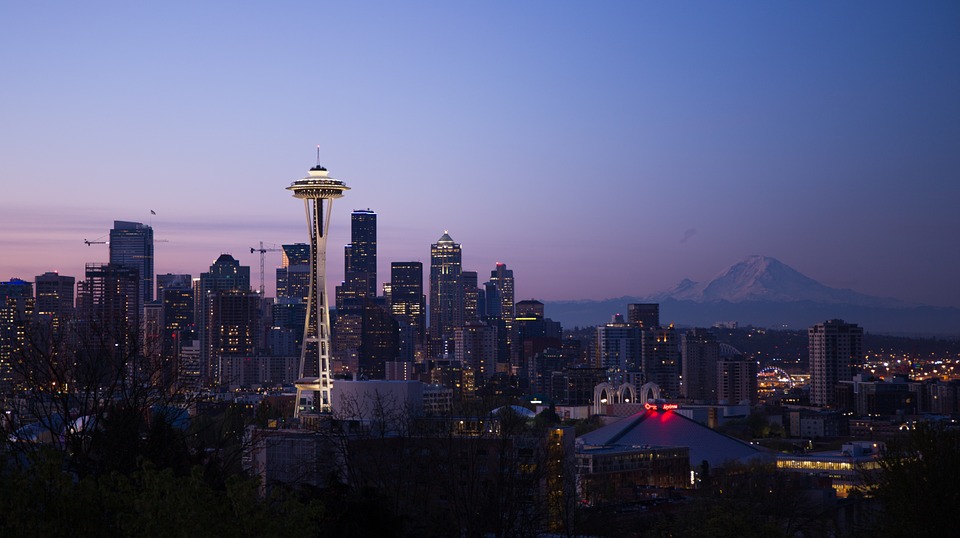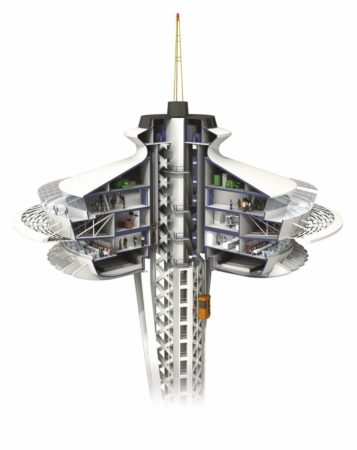The Seattle Space Needle
by Scott Dutfield · 06/03/2019

Created for the World’s Fair theme ‘The Age of Space’ in 1962, the construction of the Space Needle was out of this world
Towering above the Seattle skyline is the iconic Space Needle. If you’ve never been to the US city then you might recognise it from the title sequence of the hit show Frasier or as a cutaway feature in the medical drama Grey’s Anatomy. Before becoming a city showstopper, the Needle started out as a simple doodle on a restaurant napkin or placemat back in 1959.
While visiting Stuttgart in Germany, Edward Carlson, chief organiser of the 1962 World’s Fair, sketched a design of a Seattle building to feature centre stage and host the Century 21 Exposition. Partnering with Seattle architect John Graham, the two transformed the initial skyscraper scribble into a towering reality.
After acquiring a plot of land of nearly 1,340 square metres, a hole over nine metres deep and 36.6 metres wide was excavated to provide the foundation of the building. To fill the massive hole, 467 vehicles poured 5,600 tons of concrete and 250 tons of reinforced steel into its foundation – at the time the largest ever concrete pour attempted on the West Coast. A set of steel tripod legs was then erected, which support the famous flying-saucer-style top-house. Construction was completed in a record-breaking 400 days, in time for the World’s Fair.
Today, the Space Needle has been given a transparent transformation. Hoisted nearly 159 metres above the street below, 48 glass panels – each weighing more than a ton – replace the exterior structure of the observation deck. However, the observation deck isn’t the only thing going glass; the floors of the famous rotating SkyCity restaurant have also been replaced so diners can have a bird’s eye view of the city below.
Grand Design

-
Lightning rods: As a prominent point on the Seattle skyline, the Space Needle is equipped with 25 lightning rods to protect it from the elements.
-
Top-house: Separated into several floors, the top-house includes the SkyCity restaurant, a mezzanine level, an observation deck and the top mechanical levels.
-
Revolving restaurant: A ring around four metres thick on the lower level of the top-house contains the rotating SkyCity restaurant. It takes 47 minutes to make one revolution.
-
Elevators: Two of the three elevators can zip up the length of the Space Needle’s steel legs in just over 40 seconds and can carry 25 people each.
Top 6 facts
-
There are 848 steps from the Needle’s basement to the observation deck
-
74,000 bolts hold the tower together
-
The Space Needle’s centre of gravity is just 1.5m above the ground
-
The weight of the entire Space Needle structure is 3,700 tons
-
The Space Needle’s elevators can travel at around 4m/s
-
The Needle can withstand wind speeds of up to 322kph
This article was originally published in How It Works issue 113
For more science and technology articles, pick up the latest copy of How It Works from all good retailers or from our website now. If you have a tablet or smartphone, you can also download the digital version onto your iOS or Android device. To make sure you never miss an issue of How It Works magazine, subscribe today!





